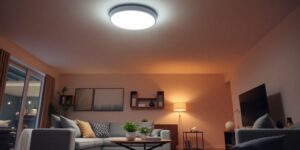In today’s era, smart homes are no longer science fiction but reality. More and more households are opting for intelligent technologies that increase living comfort, improve security, and optimize energy consumption. But what types of smart homes actually exist? In this article, we take a look at the various systems and devices that make our homes smarter.
Key Takeaways
- Smart homes use a central control unit to coordinate all devices.
- There are various application areas such as lighting, security, and entertainment.
- Important components are sensors, actuators, and network infrastructure.
- Popular devices include smart lighting and security cameras.
- Integrating smart home technologies can bring challenges like data privacy and compatibility.
The Basics of Smart Home Systems
Alright, let’s chat about the basics of smart homes. What’s really behind them, and how does it all work? Don’t worry, it’s easier than you think!
Central Control Unit
Almost every smart home has some sort of command center. Imagine it as the brain that coordinates everything. It could be an Amazon Echo, a Google Home, or something else entirely. These hubs ensure your devices can communicate with each other. They receive commands from you (via app or voice) and tell your devices what to do. Without this central control unit, your smart home would just be a collection of individual smart devices that don’t really work together.
Communication Methods
For your devices to even talk to each other, they need a common language—various wireless standards. Here are a few common ones:
- Wi-Fi: Great for devices that need to transfer a lot of data, like security cameras. But watch out, it consumes a lot of power!
- Bluetooth: Good for short distances and devices that shouldn’t use much energy. Perfect for smart bulbs or thermostats.
- Zigbee/Z-Wave: Specifically developed for smart homes. Energy-efficient with good range. Many sensors and actuators use these standards.
- Matter: The new star on the horizon! Aims to ensure that devices from different manufacturers get along better. Finally, fewer compatibility issues!
The Hardware: Smart Devices
Of course, without the right devices, nothing works. Here’s a quick overview:
- Sensors: These are the spies in your smart home. They measure all sorts of things: temperature, motion, brightness, humidity. And they pass this info on to the control unit.
- Actuators: The doers! They carry out the commands from the control unit. They turn the lights on, adjust the heating, open the blinds.
- Smart Speakers: Your personal assistants. You tell them what to do, and they take care of it. Alexa, Google Assistant, or Siri are the most well-known.
A smart home is basically like an orchestra. The central control unit is the conductor, the wireless standards are the sheet music, and the smart devices are the musicians. Only when everyone plays together does a harmonious symphony—or a comfortable and efficient home—emerge.
The Variety of Smart Home Applications
Smart home is really diverse! It’s about more than just gadgets; it’s about making your home smarter and more convenient. Here are a few areas where you can use smart home applications:
Lighting
Forget boring on-and-off! With smart lighting, you can change colors, dim, and even have the lights adjust automatically to the time of day. Imagine your lights gently brightening in the morning and mellowing in the evening.
Heating & Cooling
Never come home to a cold house again! Smart thermostats learn your habits and ensure the perfect temperature while saving energy. You can control the heating from wherever you are, so it’s always warm when you get home. Now that’s comfort!
Security & Surveillance
A secure home is a good home. With smart door locks, security cameras, and motion detectors, you can keep an eye on your house 24/7. You get notifications on your phone if something unusual happens.
Multimedia & Entertainment
Turn your living room into a home theater! With smart speakers, streaming devices, and TVs, you can take your entertainment experience to the next level. Control everything with your voice and enjoy your favorite movies and music in top quality.
Smart home isn’t just a gimmick. It can genuinely make your life easier and safer. Think about how you can make your home smarter to improve your daily routine.
And here are a few ideas for what you can automate:
- Blinds that open and close automatically
- Irrigation systems that adjust based on the weather
- Coffee machines that wake you up with fresh coffee
The Essential Components of a Smart Home
Alright, let’s check out everything you need to make your smart home truly smart. It’s not just about cool gadgets, but also how they all work together. Imagine it’s like an orchestra—each instrument (or device) has to play its part so that in the end, a beautiful song (or a smoothly functioning home) emerges.
Smart Home Ecosystems
This is basically the brain of your smart home. All the strings come together here. Think Amazon Alexa, Google Home, or Apple Home. These are the platforms through which you can control and connect your devices. It’s important that the devices you buy are compatible with your chosen ecosystem. Otherwise, it won’t work out.
- Amazon Alexa: Great if you’re already an Amazon fan. Alexa usually understands you and has a huge variety of compatible devices.
- Google Home: If you’re more into Google, this is for you. Works well with Android devices and Google Assistant.
- Apple Home: For all the Apple devotees. Very privacy-friendly, and Siri is okay too.
Sensors
Sensors are the spies in your house. They perceive everything: motion, temperature, humidity, open windows… Imagine you have a motion sensor in the hallway. As soon as someone enters, the light turns on. Handy, right?
- Motion sensors: Detect movement and can, for example, turn on lights or activate an alarm.
- Temperature sensors: Measure the temperature and help you set the heating optimally.
- Door and window contacts: Report when a door or window is opened—great for security.
Actuators
Actuators are the doers. They execute the commands from the ecosystem. For example: turn on lights, raise the heat, lower the blinds. They are the executing element.
- Smart bulbs: Can be dimmed, change color, or adjust automatically to the time of day.
- Smart thermostats: Regulate heating and ensure a comfortable temperature without wasting energy.
- Smart plugs: Turn devices on and off, even when you’re not at home.
Network Infrastructure
This is the nervous system of your smart home. Without a stable network, nothing runs. You need a good router and possibly repeaters if your home is large. And remember: not all devices communicate via Wi-Fi. Some use Zigbee or Z-Wave. You might need a bridge for those.
- Router: The heart of your network. Ensures all devices can communicate.
- Repeaters: Boost the Wi-Fi signal if it’s weak in some corners of your home.
- Bridges: Connect devices using different wireless standards (e.g., Zigbee to Wi-Fi).
A well-functioning smart home is more than the sum of its parts. It’s an interplay of intelligent software and reliable hardware. When choosing components, pay attention to compatibility and quality so you can enjoy them for a long time.
The Most Popular Smart Home Devices
Of course, a smart home is more than just a gimmick. It’s about making your life easier and more convenient. And which devices are particularly popular? Let’s take a look!
Smart Lighting
Smart lighting is really hot! You can control the lamps via app, adjust brightness, or even change color. Imagine arriving home and the lights turn on automatically, or dimming them for a cozy movie night. There are many providers, from Philips Hue to cheaper alternatives at Ikea Home smart. The selection is huge!
Security Cameras
Security cameras are great for keeping an eye on your home. Whether you want to see who’s at the door or just check that everything’s okay while you’re away. Many cameras also offer motion detection and send you a notification on your phone when something happens. A good feeling, right?
Smart Speakers
Smart speakers are basically the command center for your smart home. With Alexa, Google Assistant, or Siri, you can not only listen to music or ask questions but also control other devices. “Alexa, turn off the lights!”—and it’s dark. Plus, many smart speakers can be paired with other smart home devices, expanding the possibilities.
Connected Appliances
Connected appliances make daily life so much easier. A washing machine that tells you when it’s done, a fridge that warns you when the milk is running low, or a robot vacuum that cleans on its own—sounds good, right? Sure, it might not be absolutely necessary, but it saves time and nerves.
Smart home devices are not just gadgets; they can truly help you organize and simplify your daily life. Whether it’s automatic lighting, monitoring your home, or controlling your devices via voice command—the possibilities are endless.
The Benefits of Smart Home Technologies
Sure, a smart home might seem like a toy for tech freaks at first, but let me tell you: it really pays off in everyday life! It’s not just about remote-controlling your house but also about making your life easier, safer, and even cheaper. Sounds good, right?
Increased Comfort
Imagine coming home, and the heating is already at your comfort temperature, the lights are dimmed, and your favorite music is playing. Sounds relaxing, doesn’t it? With smart home systems, you can have exactly that. You can create routines that adapt to your daily schedule. For example:
- In the morning, the blinds automatically rise and the coffee maker starts.
- In the evening, the lights dim and the TV turns on.
- With a voice command you say, “Alexa, turn off the lights!” and it’s all quiet.
That’s pure comfort! No more hunting for switches, everything runs on its own.
Energy Saving
Another plus is that you can save a lot of energy with smart home technologies. Smart thermostats learn your heating habits and adjust the temperature automatically. And the best part? You can control them remotely. That way, you never heat unnecessarily. Lighting can also be optimized. Motion sensors ensure the light is only on when it’s really needed. That conserves both the environment and your wallet. You can also monitor energy consumption and identify energy guzzlers.
Enhanced Security
Security is a major concern, and here a smart home can help. Smart surveillance cameras, door sensors, and alarm systems protect your home from intruders. You can check what’s happening at home anytime, from anywhere. And in an emergency, you get notified immediately. Smoke detectors and water sensors can also be integrated into the system, warning you early of dangers. That way, you can sleep soundly knowing your home is well protected.
Support for People with Disabilities
Smart home technologies can also support people with disabilities in their daily lives. Voice control, automated routines, and remote control make many tasks easier and provide more independence. For example:
- Turning lights on and off via voice command.
- Adjusting the heating from bed.
- Opening and closing the door via app.
So smart home isn’t just for tech fans; it can truly improve your life. It makes your home more comfortable, safer, and energy-efficient. And all of this at an affordable price. So, what are you waiting for? Start your smart home today!
Challenges in Smart Home Integration

Sure, a smart home sounds great at first, but before everything is fully automated, there are a few hurdles to overcome. Let’s take a look at what can go wrong.
Device Compatibility
You know when you buy a new gadget and it just refuses to work with the rest? That’s often the case in smart homes. Not every device gets along with every other. You really have to make sure everything harmonizes. Otherwise, you end up with tons of different apps and systems to manage. That’s annoying!
- Different manufacturers: Each one has its own approach.
- Wireless standards: Zigbee, Z-Wave, Wi-Fi— which one is right?
- Updates: Are all devices regularly updated?
Data Privacy Concerns
Your data is gold— even in a smart home. But who has access to it? And what happens to it? These are questions you absolutely need to ask yourself. Remember, every smart device collects data about you.
It’s important to be aware of which data your devices collect and how it’s used. Do your research and make informed decisions to protect your privacy.
- Encryption: Is your data securely encrypted?
- Passwords: Are you using strong passwords and enabling two-factor authentication?
- Manufacturers: How trustworthy is the manufacturer of your devices?
Installation and Setup
Installation can be pretty tricky. Sometimes it’s easy, sometimes you almost need an engineer. And then there’s the setup! Every app, every device wants to be installed and configured. It can drive you crazy.
- Complex manuals: Are the instructions understandable or like a book with seven seals?
- Network issues: Is your Wi-Fi stable?
- Technical know-how: Do you have enough tech skills to install everything yourself?
Future Outlook: Trends in the Smart Home Sector

Hey, let’s look into the future of smart homes! What can we actually expect? It’s definitely going to be exciting, as the technology is evolving at lightning speed. Here are a few trends you can look forward to:
New Technologies
There’s a lot coming our way! Artificial intelligence (AI) will play an increasingly important role. Imagine your house learns your habits and adjusts itself automatically. Your smart home would then know exactly when you need light, when to raise the heating, and when to lower the blinds. Additionally, new sensors and actuators will be developed that enable even more precise measurements and controls. Think improved environmental sensors that measure air quality or noise levels and react accordingly.
Expanded Automation
Automation is already cool, but it gets even better! In the future, we’ll see even more automated processes. For example:
- Smart irrigation systems: They detect when your plants need water and water them automatically.
- Automatic windows: They open and close by themselves to regulate indoor air quality.
- Intelligent refrigerators: They reorder groceries on their own when supplies run low.
Automation will reach a point where you won’t have to worry about many everyday tasks. Your house will practically become your personal assistant.
Sustainability in the Smart Home
Sustainability is a huge topic, and smart homes can also contribute. It’s about saving energy and conserving resources. Here are a few examples:
- Intelligent energy management systems: Optimize your energy consumption and help you save electricity.
- Solar panels: Integrated into your smart home to make the best use of the power you generate.
- Water-saving systems: Reduce your water usage without sacrificing comfort.
| Feature | Description smart home
Conclusion: Your Entry into the Smart Home World
So, if you’re considering making your home a bit smarter, there are plenty of possibilities. From lighting to security, everything can be connected and controlled. And the best part? You don’t have to buy everything at once. Start small, see what’s important to you, and expand gradually. It’s easier than you think, and you’ll quickly notice how much more comfort and security a smart home offers. So, what are you waiting for? Make your home smarter!
Frequently Asked Questions
What is a smart home?
A smart home is a home in which various devices are connected so that they can be controlled centrally.
How does a smart home work?
A smart home works via a central control unit that networks all devices. These devices can then be controlled via apps or voice commands.
Which devices are part of a smart home?
Smart home includes smart lighting, security cameras, intelligent speakers, and connected appliances.
How secure are smart home systems?
The security of smart home systems can vary. It’s important to choose devices from trusted manufacturers and take security precautions.
Can I set up my smart home myself?
Yes, many smart home devices can be easily installed by yourself without requiring structural changes.
What are the benefits of smart home technologies?
The benefits are more comfort, energy savings, increased security, and support for people with disabilities.



